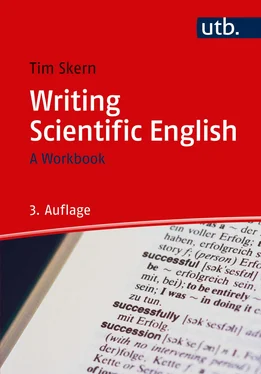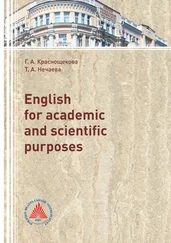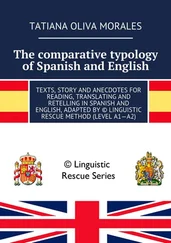Using PSDM method, we observe the shift in the specificity of the treatment. During the normal design of medicines, specificity is obtained from experience of the scientists. In the PSDM method, the specificity is obtained from the genes of the patient. Specificity of the PSDM method can be augmented by adding information from the family members. The PSDM method is estimated to increase specificity by factor of five.
1.3Words for writing scientific English
Words don't come easy.
F.R. DAVID
The English language has, as mentioned in section 1.1, a rich vocabulary. Nevertheless, box 1.7presents a suggestion for a basic scientific lexicon that contains only about 200 of the thousands of words available. Learn the meaning of these words and use them actively in your writing. If you can exploit the words from this lexicon, your scientific writing will rapidly become stronger and more mature.
The majority of the words from the basic scientific lexicon were used in writing this book. Up to five illustrative examples of their use in this book are marked in italics. section 8.2provides the pages on which the marked words can be found. If the use of a word in this book does not make its meaning clear, refer to a dictionary or a thesaurus.
An alternative approach to finding the meaning of a word from box 1.7is to look for words in scientific databases. Examples of these databases include PubMed ( www.pubmed.gov) or Google Scholar (scholar.google. com); others are listed in section 7.1. Searching these databases for an unknown word will provide you with many articles that have your word of interest in the title or in the abstract. From these, you should be able to obtain hints on the meaning of the word and see how it is used in scientific writing. As an exercise, try to determine the meaning of the important scientific words “purport”, “pinpoint”, “feasible”, “plausible” and “flaw” by typing them into PubMed. Actively investigating the meaning of words in this way will help you to use them more regularly in your own writing.
Box 1.7A basic lexicon for scientific writing
Verbs
accumulate
adapt
affect
ask
assay
attempt
cause
cite
compare
conclude
confirm
confuse
consider
correlate
decline
decrease
deduce
demonstrate
describe
destroy
detect
deteriorate
disprove
disturb
document
evidence
explain
falsify
find
follow
illustrate
increase
indicate
induce
infer
interest
invent
investigate
judge
maintain
observe
oppose
pinpoint
point to
propose
prove
purport
quantify
quote
record
remain
repeat
reproduce
require
screen
search
shed light on
show
solve
strengthen
suggest
support
survive
test
treat
try
underline
vary
verify
work
Nouns
absence
activation
analysis
answer
appearance
application
attempt
background
blank
cause
chance
change
citation
clue
component
condition
conflict
consequence
constant
control
curve
data
decrease
difference
discovery
discrepancy
distribution
dose-response
effect
enigma
equilibrium
event
evidence
exclusion
experiment
figure
flaw
function
graph
hint
hypothesis
idea
illustration
image
inclusion
increase
incubation
ingredient
input
interaction
level
mechanism
mock
model
mystery
observation
output
panel
paradox
parameter
participant
pathway
performance
period
possibility
prerequisite
presence
process
product
question
ratio
reason
relevance
report
research
result
role
signal
situation
solution
specificity
structure
synthesis
table
target
theory
variable
variation
variety
version
volunteer
work
Adjectives and adverbs
able
active
actually
affected
artificial
associated
aware
capable
certain
closely
consistent
contradictory
correct
dependent
detrimental
essential
exactly
exclusively
external
feasible
frequent
incorrect
internal
inversely
likely
limited
linear
multiple
necessary
noteworthy
particular
pertinent
plausible
poorly
previous
prior
proportional
putative
random
relevant
resistant
robust
severe
significant
similarly
simultaneous
unable
variable
1.4Take-home messages from Chapter 1 Chapter 1An introduction to scientific English It is well-known that, in grammatical terms, languages are more perfect the older they are and that they always become gradually worse, from high Sanskrit down to English jargon, this patchwork cloak of thoughts stitched together from rags of heterogeneous material. (Bekanntlich sind die Sprachen, namentlich in grammatischer Hinsicht, desto vollkommener, je älter sie sind, und werden stufenweise immer schlechter – vom hohen Sanskrit an bis zum englischen Jargon herab, diesem aus Lappen heterogener Stoffe zusammengeflickten Gedankenkleide.) ARTHUR SCHOPENHAUER The chapter begins by looking at the advantages and disadvantages of English as the language of scientific communication, presents some guidelines on how to write the formal English found in scientific writing and ends by suggesting a basic vocabulary for written scientific communication.
❚ Use a spellchecker
❚ Use formal English
❚ Use linking words
❚ Use words from a basic scientific lexicon
Bryson, B. (1990) Mother Tongue: The English Language.
http://scholar.google.com
www.krysstal.com/borrow.html
www.pubmed.gov
1.6Improvements to exercices
1.6.1Solutions to box 1.2“Fooling a spellchecker”
1. You must prove that two plus two equals four!
2. A proof that two plus two equals four is given on the first page.
3. Vaccines save lives.
4. Spellcheckers change the way we read our texts.
5. The theory of global warming remains to be proven.
6. Spellcheckers affect our ability to spell.
7. How do tortoises remain alive when hibernating?
8. Only a few scientists have received two Nobel Prizes.
9. The effect of technology on the environment is substantial.
10. We lose the loose screw.
11. We judge how we live our lives from our own perspective.
12. The ability to write concisely and accurately is not hereditary.
13. The price of the prize was a surprise.
1.6.2Improvements to box 1.6“Practising the use of the articles “the” and “a” in English”.
The patient-specific design of medicines (PSDM) is a novel method which was first described by Smith and Jones. The PSDM method is based on conventional designs modified by using an alternative gene-based protocol. The main feature of the PSDM approach is its high specificity of treatment. The principle of the PSDM approach is depicted in Figure 1.
Читать дальше












